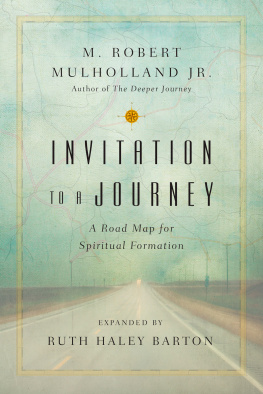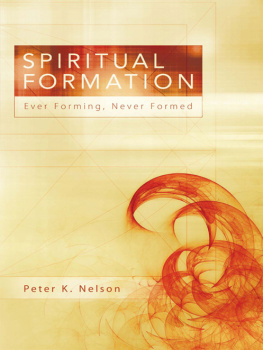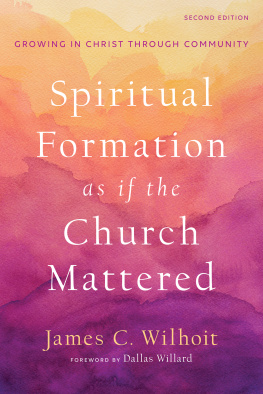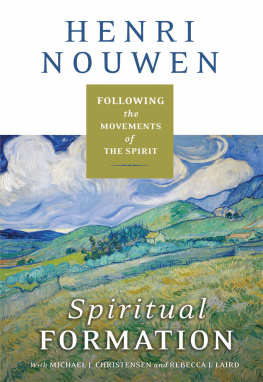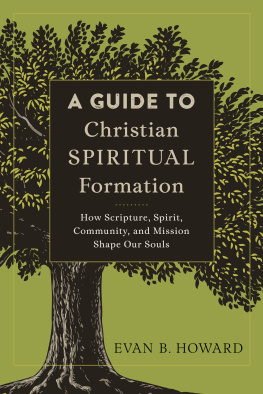
Formatio books from InterVarsity Press follow the rich tradition of the church in the journey of spiritual formation. These books are not merely about being informed, but about being transformed by Christ and conformed to his image. Formatio stands in InterVarsity Presss evangelical publishing tradition by integrating Gods Word with spiritual practice and by prompting readers to move from inward change to outward witness. InterVarsity Press uses the chambered nautilus for Formatio, a symbol of spiritual formation because of its continual spiral journey outward as it moves from its center. We believe that each of us is made with a deep desire to be in Gods presence. Formatio books help us to fulll our deepest desires and to become our true selves in light of Gods grace.
INVITATION
TO A JOURNEY
A Road Map for
Spiritual Formation
M. ROBERT
MULHOLLAND JR.
Foreword, Practices and Study Guide by
RUTH HALEY BARTON
InterVarsity Press
P.O. Box 1400, Downers Grove, IL 60515-1426
ivpress.com
Expanded edition 2016 by Gweneth Lynn Mulholland
First edition 1993 by M. Robert Mulholland Jr.
All rights reserved. No part of this book may be reproduced in any form without written permission from InterVarsity Press.
InterVarsity Pressis the book-publishing division of InterVarsity Christian Fellowship/USA, a movement of students and faculty active on campus at hundreds of universities, colleges and schools of nursing in the United States of America, and a member movement of the International Fellowship of Evangelical Students. For information about local and regional activities, visit intervarsity.org.
New Testament quotations, unless otherwise noted, are the authors own translation. Old Testament quotations, unless otherwise noted, are from the Revised Standard Version of the Bible, copyright 1946, 1952, 1971 by the Division of Christian Education of the National Council of the Churches of Christ in the U.S.A. Used by permission. All rights reserved.
While any stories in this book are true, some names and identifying information may have been changed to protect the privacy of individuals.
Cover design: Cindy Kiple
Images: compass: pauloribau/iStockphoto
country road: Jamie Heiden / Trevillion Images
ISBN 978-0-8308-9373-7 (digital)
ISBN 978-0-8308-4617-7 (print)
This digital document has been produced by Nord Compo.
To
Darrell
John
Steve
Steve
brothers
in Christ
and
Gods nurturing
community
FOREWORD
Ruth Haley Barton
W hen the student is ready, the teacher will appear, the saying goes. That is certainly what happened to me with Bob Mulholland and his book Invitation to a Journey. When I encountered the book you have in your hands, I was in my early thirties and had come to the end of what typical evangelical discipleship models had to offer. I had already begun seeking spiritual direction and other spiritual practices (solitude, silence, lectio divina, the examen) that came from the broader Christian tradition but had somehow been missing in my own. But all of this was on the down low. No one in the circles I was a part of seemed to know how to deal with me at that pointthe questions I was asking, the dead ends I was acknowledging in my Christian growth, the longing I had for more of God, and my utter disillusionment about the fact that many of us who had been Christians for so long were not really changing.
Truth is, no one beyond my immediate family knew the lengths to which I was going to seek out more.
GOOD NEWS, BAD NEWS
The good news is that these new avenues I was exploring were working! Outside the confines of my narrow religious upbringing, I was finding life, joy, intimacy with God and freedom from bondage to the false self beyond what I had thought possible. The bad news is that there was no way to talk about it without being accused of being New Age, Buddhist or just plain liberal. It was quite the conundrumthe best thing that had happened to me in a long time was something I couldnt share freely with most of the Christian people I knew. I knew I believed in God and Jesus, but that was about it.
Then I enrolled in seminary. Imagine my wonder and surprise when one of my first seminary courses was called Introduction to Spiritual Formation (who even knew what that was at the time?) and the course description seemed to be describing exactly what I had been experiencingespecially hints about the classic stages of faith! I registered immediately, and one of the assigned texts was Invitation to a Journey by M. Robert Mulholland.
My teacher had appeared.
NEW TESTAMENT PERSPECTIVES
That was 1994. Invitation to a Journey had just been published, and I was riveted. Here was a New Testament scholar and theologian who was unpacking what I had been experiencing spiritually but from a deeply biblical, richly theological point of view. I entered in with heart, soul, mind and strength. Recently when I pulled out the coursework from that long-ago class, I was amazed to discover an entire journal devoted to the reflections, prayers, wrestlings, groanings and wonderments inspired by this textall on the way to greater wholeness in Christ. I am even able to note aspects of Bobs teachings that I resisted and argued with then but that make all the sense in the world now, so many years of spiritual journeying later.
I see now that God used this book to change my life as well as the trajectory of my path in ministry. Finally, I was able to understandfrom a strongly biblical and theological perspectivewhat had been happening to me in the context of the spiritual disciplines I was practicing outside my former box. Finally, I was able to explain to those who were afraid I was falling off the Christian path that what was happening in my spiritual life was orthodox, deeply rooted in our own Christian tradition. And when it came to the church, finally I had the confidence to begin communicating a clear and nuanced biblical rationale for why spiritual formation is central to the message of the gospel and therefore central to the mission of the church.
Since then I have shared Mulhollands book wherever I go. When I need to choose one book to provide the biblical and theological underpinnings for those seeking a more intentional journey of spiritual transformation, this is it. There are several things that make it such a seminal work. First, his definition of spiritual formation is so clear, compelling and biblical that it is impossible to dismiss it, even for those who tend to be suspicious. Second, his systematic, brick-on-brick approach to laying a clear, biblical and theological foundation gives us all a solid place to stand as we consider how to engage more deeply in our journey toward wholeness in Christ and how we might help others. And third, his approach to describing the process of spiritual formation is highly integrative and therefore, quite comprehensive.
He integrates personal spiritual disciplines with the communal aspects of our faith.
He brings together psychology, spirituality and an understanding of the human personality in fruitful synergy.
He is precise in his ability to talk about sin, but always in the context of grace eloquently described.

